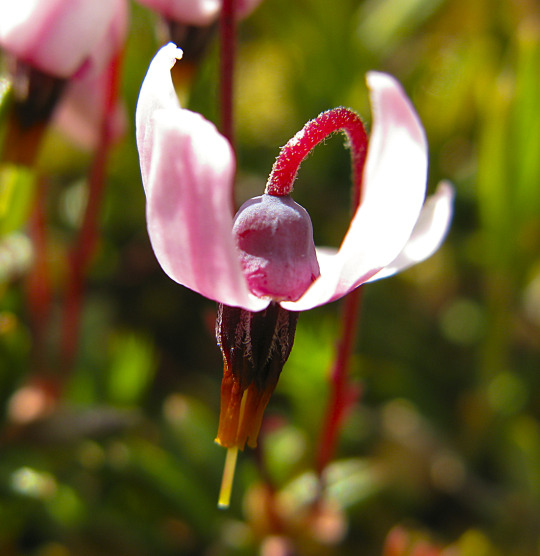Photo

“An illustrated lecture in China takes place outdoors in a village street, two men pushing brightly colored pictures along a two-row panel while they chant some ancient story”
- Wandering in Northern China by Harry Alverson Franck, 1923
21 notes
·
View notes
Text
Cranberry
The word “cranberry” was a contraction of crane berry, an early name given to the berries because their pale pink blossoms resembled the head of a crane. Cranes were seen in the lowlands, enjoying the berries.
14 notes
·
View notes
Photo

Bacchus and Ariadne by Angelica Kauffmann, 1794
25 notes
·
View notes
Text
Vulcanalia
A festival celebrated at Rome in honour of Vulcan, on the 23rd of August, with games in the circus Flaminius, where the god had a temple. The sacrifice on this occasion consisted of fishes, which the people threw into the fire. It was also customary on this day to commence working by candle-light, which was probably considered as an auspicious beginning of the use of fire, as the day was sacred to the god of this element.
10 notes
·
View notes
Text
Veneficium
The crime of poisoning, is frequently mentioned in Roman history. Women were most addicted to it: but it seems not improbable that this charge was frequently brought against females without sufficient evidence of their guilt, like that of witchcraft in Europe in the middle ages. We find females condemned to death for this crime in seasons of pestilence, when the people are always in an excited state of mind, and ready to attribute the calamities under which they suffer to the arts of evil-disposed persons.
9 notes
·
View notes
Text
Thyrsus
A pole carried by Bacchus, and by Satyrs, Maenades, and others who engaged in Bacchic festivities and rites. It was sometimes terminated by the apple of the pine, or fir-cone, that tree being dedicated to Bacchus in consequence of the use of the turpentine which flowed from it, and also of its cones, in making wine. The monuments of ancient art, however, most commonly exhibit, instead of the pine-apple, a bunch of vine or ivy-leaves, with grapes or berries, arranged into the form of a cone. The fabulous history of Bacchus relates that he converted the thyrsi carried by himself and his followers into dangerous weapons, by concealing an iron point in the head of the leaves. Hence his thyrsus is called “a spear enveloped in vine-leaves,” and its point was thought to incite to madness.
21 notes
·
View notes
Text
Testudo
A tortoise, was the name given to several other objects:
To the Lyra, because it was sometimes made of a tortoise-shell.
To an arched or vaulted roof.
To a military machine moving upon wheels and roofed over, used in besieging cities
To the covering made by a close body of soldiers who placed their shields over their heads to secure themselves against the darts of the enemy.
7 notes
·
View notes
Photo

Erythraean Sibyl by Michelangelo
14 notes
·
View notes
Text
Syrinx
The Pan’s pipe, or Pandean pipe, was the appropriate musical instrument of the Arcadian and other Grecian shepherds, and was regarded by them as the invention of Pan, their tutelary god. It was formed in general of seven hollow stems of cane or reed, fitted together by means of wax, having been previously cut to the proper lengths, and adjusted so as to form an octave; but sometimes nine were admitted, giving an equal number of notes.
7 notes
·
View notes
Text
Sycophantes
At an early period in Attic history a law was made prohibiting the exportation of figs. Whether it was made in a time of dearth, or through the foolish policy of preserving to the natives the most valuable of their productions, we cannot say. It appears, however, that the law continued in force long after the cause of its enactment, or the general belief of its utility, had ceased to exist; and Attic fig-growers exported their fruit in spite of prohibitions and penalties. To inform against a man for so doing was considered harsh and vexatious; as all people are apt to think that obsolete statutes may be infringed with impunity. Hence the term sycophantes, which originally signified to lay an information against another for exporting figs, came to be applied to all ill-natured, malicious, groundless, and vexatious accusations.
16 notes
·
View notes
Text
Siparium
A piece of tapestry stretched on a frame, which rose before the stage of the theatre, and consequently answered the purpose of the drop-scene with us, although, contrary to our practice, it was depressed when the play began, so as to go below the level of the stage, and was raised again when the performance was concluded.
4 notes
·
View notes
Text
Sibyllini Libri
These books are said to have been obtained in the reign of Tarquinius Priscus, or according to other accounts in that of Tarquinius Superbus, when a Sibyl, or prophetic woman, presented herself before the king, and offered nine books for sale. Upon the king refusing to purchase them, she went and burnt three, and then returned and demanded the same price for the remaining six as she had done for the nine. The king again refused to purchase them, whereupon she burnt three more, and demanded the same sum for the remaining three as she had done at first for the nine; the king’s curiosity now became excited, so that he purchased the books, and then the Sibyl vanished. The Sibylline books were also called Fata Sibyllina and Libri Fatales.
5 notes
·
View notes
Photo

Gold Rhyton, from Ecbatana.
21 notes
·
View notes
Text
Rhyton
A drinking-horn. Its original form was probably the horn of the ox, but one end of it was afterwards ornamented with the heads of various animals and birds. The rhyton had a small opening at the bottom, which the person who drank put into his mouth, and allowed the wine to run in: hence it derived its name.
5 notes
·
View notes
Text
Quinquatrus
A festival sacred to Minerva, which was celebrated on the 19th of March. Ovid says that it was celebrated for five days, that on the first day no blood was shed, but that on the last four there were contests of gladiators. It would appear, however, that only the first day was the festival properly so called, and that the last four were merely an addition made perhaps in the time of Caesar, to gratify the people, who became so passionately fond of gladiatorial combats.
3 notes
·
View notes
Text
Psycter
A wine-cooler, was sometimes made of bronze or silver. One of earthenware is preserved in the Museum of Antiquities at Copenhagen. It consists of one deep vessel for holding ice, which is fixed within another for holding wine. The wine was poured in at the top. It thus surrounded the vessel of ice and was cooled by the contact. It was drawn off so as to fill the drinking-cups by means of a cock at the bottom.
5 notes
·
View notes
